Where to go in Switzerland on a short trip: Alps, lakes, and cities
Switzerland is an extremely popular country for those planning multi-stop tours around Europe, yet very few potential first-time visitors actually know specifically where they want to go. Everyone seems to know that it has the most beautiful views of the Alps and some very impressive cities, but there are actually many misconceptions among casual trip planners, so I’d like to clear most of that up below. The places to visit in Switzerland are not obvious until you’ve been there yourself or done many hours of research, so the list below should be a short cut.
I get hundreds if not thousands of itinerary questions for people who are considering a Eurail trip around Europe, and most people just include the word “Switzerland” among a list of cities like Paris, Rome, and Berlin that they want to visit. So where in Switzerland should you go if you can only make a few stops at most? I’ll answer that question below. You’ll mostly want to focus on the best choices for Swiss Alps trips, which I’ll go over below.
Note: This article was expanded and updated in February, 2024.
Switzerland is about outdoor views rather than city visits
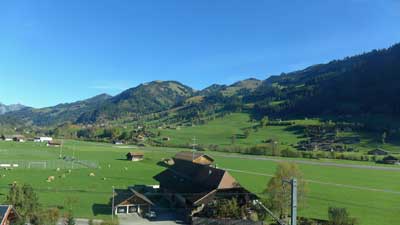
Geneva is a very famous city (though not for tourism reasons) on a lovely lake of the same name, but it’s also notoriously dull and lacking distinction. Rick Steves puts it well by saying that “Geneva is pleasantly situated on a lake, like Buffalo or Cleveland.” The point is, you don’t want to go to Geneva unless you’ve got something specific in mind that you want to see there. There are much better places to visit in Switzerland if your time is limited, or even if it’s not.
Switzerland's cities in summary
Zurich – The largest city, very expensive, geared towards business travelers. It’s generally a pretty and very well-run city that you would enjoy if you visited, but it’s not nearly as interesting as the likes of Vienna, Munich, or of course Paris.
Geneva – Second largest city, in the French part of the country, no major sights. Again, if you visited you’d be very impressed by it and get some great photos, but it’s not worth your time unless you know someone there. There’s an impressive fountain in the lake and you can usually see it from the train as you go through the city, but it’s not really worth going there and staying more than an hour or so.
Basel – Bordering France and Germany, no major sights. It has the famous art market each year, and aside from that it’s even duller than the ones above. Again, if you visited you’d be impressed, but if you later compared photos with friends who went to the Lauterbrunnen Valley instead, you’d kick yourself for going to Basel.
Lausanne – Near Geneva in the French part of the country, very hilly, and certainly more interesting than Geneva.
Bern – The capital, compact, on a lovely river, some interesting sights and the best Swiss city to get a feel for the culture. Bern is fairly close to Interlaken (which we will discuss below) and it can be a great day trip from there, especially on a day where it is foggy and/or rainy in the mountains (and this happens a LOT).
How much time and which Swiss cities to visit?
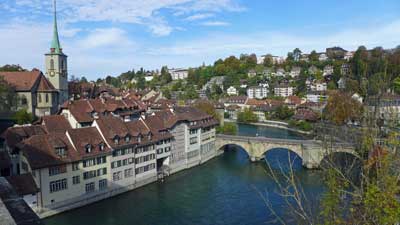
Many people (me included) don’t feel as if they’ve scratched the surface of a new country if they haven’t spent at least a day or two in the largest city. Zurich is certainly pleasant and a useful transit hub so spending one or two nights there wouldn’t be a major mistake. But Zurich isn’t even close to being a city like Paris, Rome, Berlin, Amsterdam, or even Vienna. If you skip it in favor of spending more time in the Swiss Alps, you won’t be missing much.
The 2 Best places to visit in Switzerland for short visits
Interlaken – If you want the best possible Alpine views and activities, head to the Interlaken area, which will be described in detail below. This is my favorite of all places to visit in Switzerland and it will probably be yours as well.
Lucerne – The traditional Swiss tourist retreat, Lucerne is a small city with interesting culture and sights, that is gorgeously set on a lake with plenty of top activities surrounding it.
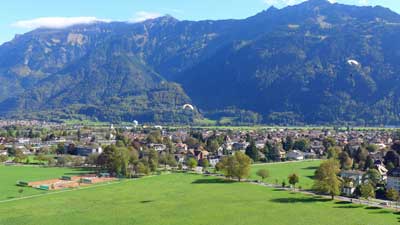
>>>Interlaken and Lucerne: Which to choose and how long to stay in each?
The article linked above will give you more details on which to choose and how long to spend in each place.
What about Zermatt for Alpine views?
Zermatt is a remote car-free village in southern Switzerland that is famous for being the place to see the Matterhorn mountain. It’s also a busy ski resort area, and aside from that, there isn’t much to see or do here. It’s on a private rail line, so it’s more complicated and usually more expensive to reach than Interlaken.
In other words, unless you’ve irrationally placed “Seeing the Matterhorn in person” on your so-called bucket list, skip Zermatt and head to Interlaken on a shorter visit. You won’t be sorry. If you already have enough time in your visit for the main sights around Interlaken and Lucerne and you want to also see the Matterhorn, then by all means go and you’ll enjoy it. There are quite a few other car-free villages in the Lauterbrunnen Valley near Interlaken, so they are not as novel in Switzerland as one might expect.
A weekend in Switzerland? What to see in 3 days
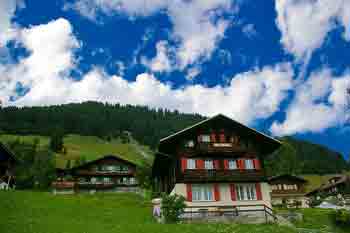
One challenge is that neither has an international airport so you’ll either be flying into Zurich or perhaps Geneva.
Train times from Zurich to Lucerne to Interlaken and back
- Zurich Airport to Lucerne: 1 hour 10 minutes by train
- Lucerne to Interlaken: 2 hours by train
- Interlaken to Zurich Airport: 2 hours 15 minutes by train
As you can see with the travel times above, Zurich Airport to Lucerne is a fairly short trip, but once you add Interlaken into the mix (even if you skip Lucerne) the travel time starts to add up for a weekend visit. With this in mind it’s probably best to just choose one of them and save the other one for another trip.
Lucerne is gorgeous, but the Lauterbrunnen Valley near Interlaken is really the star of the show, so I’d recommend going there first and doing Lucerne on another trip.
What about the Swiss Travel Pass?

The bottom line is that if you are coming to Switzerland for at least 3 days and you want to take 2 or more of the amazing scenic rail journeys that the country is famous for, the travel pass is probably a good deal. It also provides 50% discounts on the Schilthorn cable car and 25% off the Jungfraujoch mountain railway. Both of those are quite expensive on their own, but extremely worthwhile, so the discount is helpful.
The Half Fare Card is probably a better deal for most people
The Swiss Travel Pass is a good deal for those who are going to be spending at least 2 or 3 days riding the rails and seeing Switzerland that way. But if you are mostly going to be focusing on Interlaken and Lucerne and the mountain sights, the Half Fare Card is the best option. For CHF120 (about US$134) you get the card that is good for 30 days and gives you a 50% discount on all trains, cable cars, mountain railways, and other sights and attractions. If you are doing either Schilthorn or Jungfraujoch, the Half Fare Card practically pays for itself with just one of those.
>>>Buy the Swiss Half Fare Card
Many people have questions about the Swiss Half Fare Card so I will explain it a bit here. You can actually buy half price train tickets for travel within Switzerland any time you want and you will see that option when you go to buy them online. The only thing is you have to have and present a valid Half Fare Card when you get on the train and are asked to see your ticket. In other words, you can buy a half fare train ticket today and buy a Half Fare Card just before you get on that train months in the future, and you are fine.
How and why visit the area around Interlaken
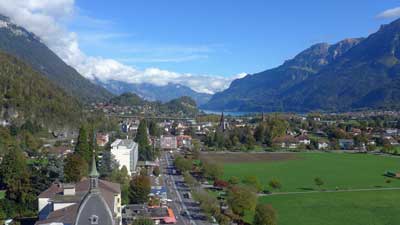
You can see everything discussed below by actually staying in a hotel in Interlaken, but it’s not the Alpine experience that you get if you stay in one of the small villages nearby. You can reach those villages in 20 to 40 minutes from the Interlaken Ost (East) train station, and it’s much easier than it sounds.
The 3 best places to stay to visit the Swiss Alps
Lauterbrunnen – A private train line runs from Interlaken Ost station to the end of its line in Lauterbrunnen. There’s a lovely waterfall here and great hiking trails, but you should probably only stay here if you can’t get to one of the villages mentioned just below. It’s a great little transit hub and it’s definitely gorgeous, so it can be worth a night if you’ve got one to spare.
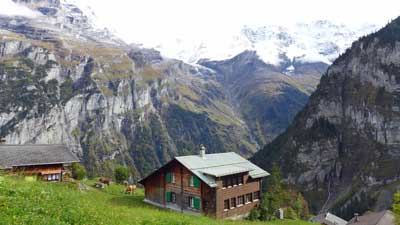
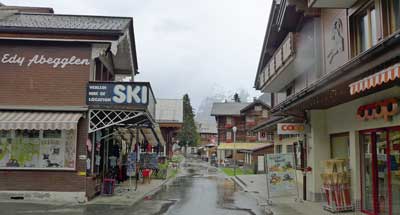
Where to stay in Interlaken and the Lauterbrunnen Valley (with pics)
I get so many questions about where to stay in the Interlaken area that I decided to write a longer version of it and load it with huge photos so readers can get a better feel for each option. I also included recommendations for affordable and well-located photos in each area.
>>>Where to stay in Interlaken and the Lauterbrunnen Valley New for 2024!
The unforgettable things to see here (if the weather is decent)
Schilthorn observation deck and restaurant
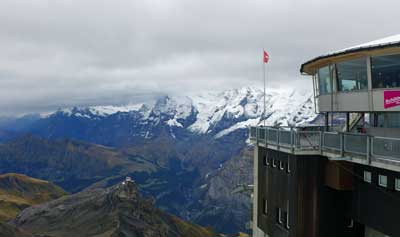
There is a rotating restaurant (with prices similar to normal Swiss restaurants) and a bizarre and anachronistic James Bond attraction based on it being a key location in the 1969 movie On Her Majesty’s Secret Service. The Bond thing is included with the lift, and it’s worth a look.
But the main thing you come here for is the 360-degree view from one of the highest peaks in Europe. Again, the weather here is key, but fortunately all the locals track the visibility on a minute-by-minute basis. If it’s clear up top while you are in the area, it would be a terrible shame to skip it based on the high price. But even if it’s cloudy up top, there are still plenty of wonderful things to see and do in the villages below.
Jungfraujoch observation area
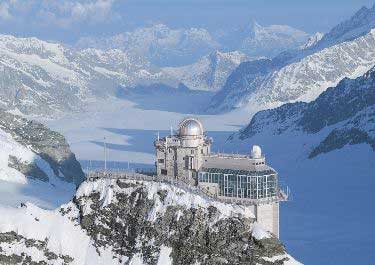
The views from the top are similar to the views from Schilthorn, from the other side of the Lauterbrunnen Valley. Once on top you can have lunch, hike, or even go sledding. It’s also quite expensive at nearly US$200 round-trip unless you have a Swiss Pass or a Eurail Pass for discounts, and it takes most of your day, but you’ll never forget the views from the top.
Harder Kulm mountain and Two Lakes Bridge Observation Deck
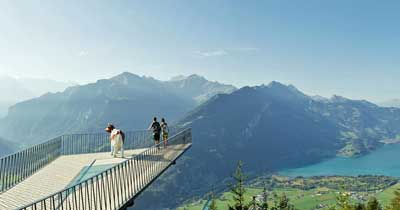
There’s a revolving restaurant about 10 minutes’ walk from the station at the top, which is definitely an unforgettable place for lunch if you’ve got time. It’s not as expensive as you might expect, at least compared to normal restaurants in Switzerland.
The Harder Kulm Railway goes from early April through late November each year. If you are only in Interlaken for one day and/or you are on a strict budget, this is the fastest and best way to get amazing Alpine views in the area.
Getting from Interlaken to Gimmelwald and Mürren
Getting up to these villages sounds complicated and time consuming, but it’s actually fast and easy once you get there. This little guide should help.
Arrive in Interlaken
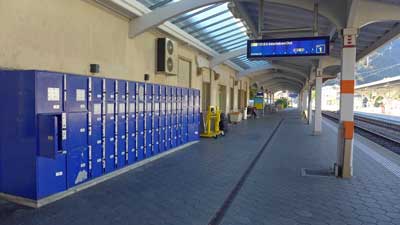
Once you arrive at the Interlaken Ost train station, head for the ticket windows in the office and buy a ticket to your final destination (Lauterbrunnen, Gimmelwald, or Mürren). Eurail passes are good for 25% discounts on the rest of the trip, but not for the whole thing.
From Interlaken Ost to Lauterbrunnen
The private train leaves Interlaken Ost every 30 minutes and arrives in Lauterbrunnen 20 minutes later. If you are staying in Lauterbrunnen then you are probably walking distance from your hotel when you reach the station.
From Lauterbrunnen to Gimmelwald
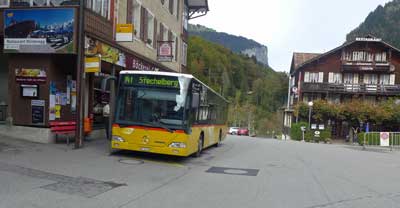

From
Gimmelwald to Mürren
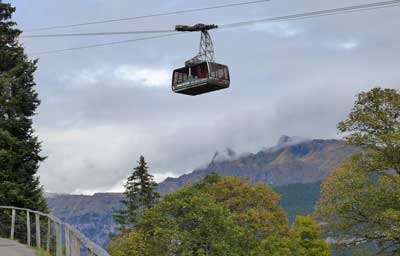
Recommended hotel and hostel in Gimmelwald
I get asked all the time about where to stay in Gimmelwald, so here it is:
Hotel: Esther’s Guesthouse
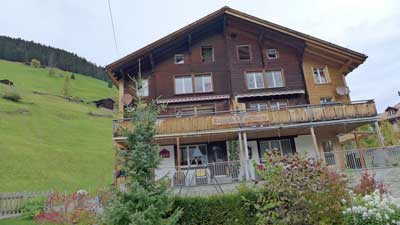
It’s run by Esther, as you might guess, and she is very friendly speaking excellent English. Each room is different and the place feels like a mountain cabin, because it is. She offers an excellent buffet breakfast in the morning, which you have to order the night before. It’s not cheap, but it’s worth it because it’s hearty and there are no other good options nearby.
Book as early as possible because this place is often the first place to sell out in Gimmelwald.
Hostel: Mountain Hostel Gimmelwald
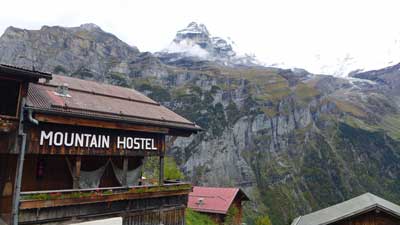
You won’t believe the views from this place, which are the same as from Esther’s except a bit lower and more unobstructed. This place also has a busy bar and restaurant that is basically the only “nightlife” in Gimmelwald. Many hikers get to bed early in this tiny village, but if you want to have a couple drinks and order a pizza or some local options, this is the place to go.
Again, book early because this place is always sold out.
Lucerne and what to do there
Luzern, as it’s spelled locally, is the other traditional holiday destination in Switzerland. Unlike Interlaken, Lucerne actually qualifies as a small city rather than a small resort town, so it’s a very nice contrast and very worthwhile. We have a new article with advice on where to stay in Lucerne and it should be helpful.
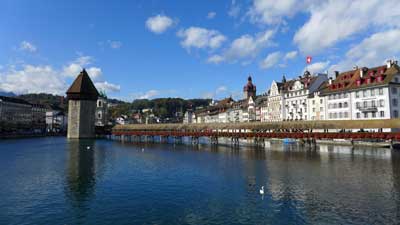
However, unlike Interlaken, the town of Lucerne itself is a great attraction and worth at least a day of exploration. This has always been a rich area so you can expect to find all of the high-end shops and boutiques along the small streets just north of the lake, but there are also many traditional shops and things to see that will appeal to anyone.
Recommended hotel in Lucerne
>>Hotel Des Alpes (3 stars with an amazing location and view)

If this place is booked, which is often the case, then book a hotel as close to it as you can find or afford. The whole historic part of town surrounding it is lovely, with restaurants, bars, and high-end shops. There are also a couple of nearby supermarkets where you can buy inexpensive alcohol and picnic supplies to keep other costs down.
Spend a day in Lucerne itself
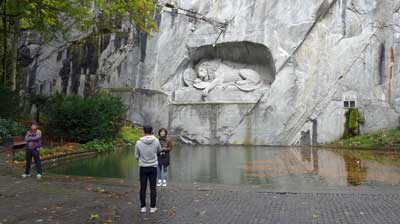
Most of the interesting part of Lucerne is in the area behind those restaurants, and it’s certainly worth doing a self-guided walking tour if not a guided one. Heading farther east you’ll come to another older part of town where the famous lion statue is located. You can’t visit Lucerne without having a look at the lion, and fortunately it’s easy and quick to reach (and it’s free).
Take a lake cruise of some kind
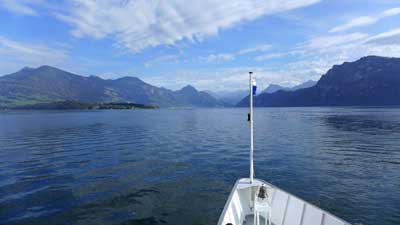
Especially in nice weather, even the short lake tour is lovely, and if you have more time you can jump off at Vitznau and do the scenic hike up Mount Rigi. There are also small lakeside villages that are ideal for a stroll and lunch stop. Long story short, there are dozens of interesting sightseeing options that are available using part of the boat tour, and the views all around are wonderful.
Visit Mount Pilatus
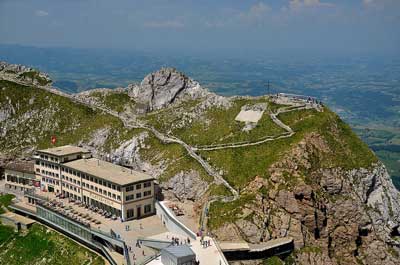
You can take the cogwheel train up and have a more or less flat hike around the summit area, and then take the gondola and cable car back down again. You can do them in the other order, and the cost is the same either way. At around US$65, this is not a cheap hike, but like most everything in Switzerland, the quality is high so it doesn’t feel like a rip-off. You can reach the cable car in 10 minutes on a public trolly bus from Lucerne.
Visit Mount Rigi
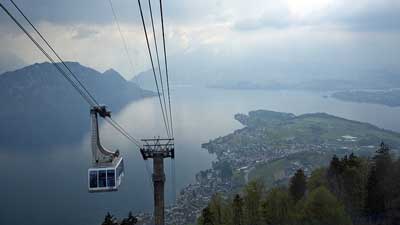
Unlike the other peaks mentioned in this article the Swiss Travel Pass covers both ways to get up and down for free. The others are 50% off with the Swiss Travel Pass or Half Fare Card, except for Jungfraujoch, which is only 25% off with the Swiss Travel Pass and still 50% off with the Half Fare Card.
Visit Mount Titlis
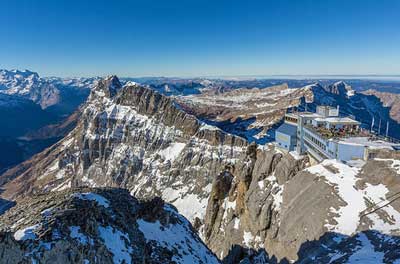
You can reach Titlis by taking a 43-minute train ride from Lucerne to Engelburg and then taking the cable car up from there. As with the others, it’s wise to check the weather immediately before you are going to depart because it can be foggy or cloudy any time of the year, but usually not for whole days at a time.
Additional photo credits
Jungfraujoch by cupweuro on Flickr, Pilatus by Tony Fernandez on Flickr, Rigi by Kosala Bandara on Flickr, Titlis by PaulSchliebs on Flickr

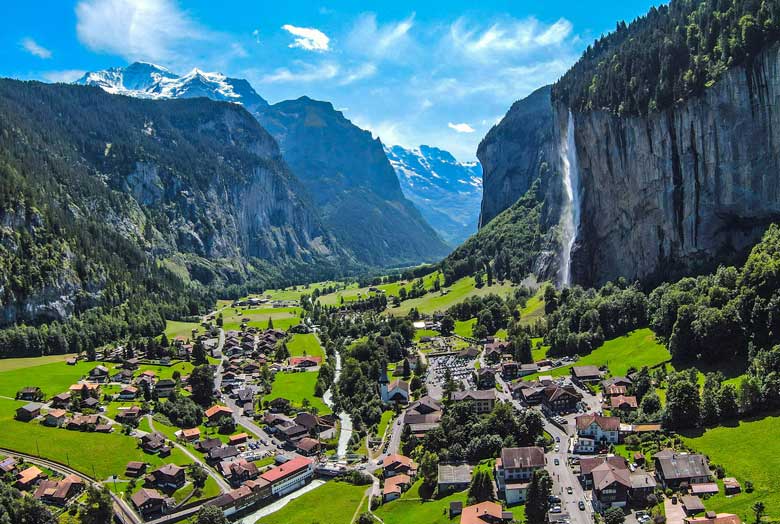
Thank you, Roger, My first decider where to go is finding affordable flights
here’s what i’ve map out so far
Newark NJ to London, have cousins there visit 5 days, fly from London to Wroclaw heard its Beautiful, catch a train to Prague, visit a couch surfer friend who stayed with me, than Brno 2 nights, down to Vienna, detour over to Budapest many people have mentioned i should stop there back up to Vienna to get to Graz don’t think i can get there any quicker beside going back up.
From this point i hit a stopping point do i go down to Slovenia and Croatia?
Or continue through Austria and head to Switzerland and down to Milan, Venice, Florence and finally to Rome where i fly back home? or From Switzerland head straight to France.
Now i am self employed so i could make this a 3 month trip which i probably couldn’t afford, But planning a 5 to 6 week backpack trip, my biggest worry is getting there and getting Completely overwhelmed by their public transportation,
i did download Rome2rio which seems to make things less Intimidating, i was told to get a Europe Rail Pass and International Hostel Card.
So my biggest questions to you a man who’s not only lived there but traveled many times is
1 what countries have the best nature landscapes?
2 what should any traveler going to Europe know before leaving?
3 Besides asking friends or googling what to do in certain cities or areas find out the really unique stuff to see
4 lastly not doubting your every decision.
-Arjuna
Hello Roger,
We are family of 5 (2 adults, 3 Children) and planning to visit Switzerland between 30th July and 12 August and would like to stay 2 nights in Zurich, 4 nights in Lucern, 4 nights in Interlaken and 2 nights in Geneva. I’m planning to rent a car during the entire stay but nor sure whether it is worth? Please suggest.
Also advice other places worth visiting during the stay.
Syed,
That is a pretty long visit to Switzerland, but it’s an amazing country and I’m sure you won’t get bored. As you can see near the top of the article above, I don’t really recommend people spend much or any time in Zurich or Geneva unless there are specific things there you want to see. Both of them are very expensive, and also they are fairly bland compared to famous European cities such as Paris or Berlin. Also, the real magic of Switzerland is the amazing views and outdoor activities, so it’s a shame to spend much time in the expensive cities. But again, if you’ve got 12 days you’ll have plenty of time to see the Alps and other good sights.
In most European countries I generally discourage people from renting cars, but Switzerland is different and it might be a good idea. Mostly it’s that big cities (including Zurich and Geneva) have very expensive parking fees, especially in the city centers. But in Interlaken there are some hotels with free parking and it’s quite spread out. Lucerne is more dense, but you should be able to find fairly affordable parking not far from the city center.
On the other hand, I still very much prefer trains. You’ll definitely want to get either a Swiss Travel Pass or a Half Fare Card for each adult, and with either of those you can also get a Swiss Family Card for free, which allows one child to travel for free with a paying adult. In other words, two of your kids can take trains with you for free while you either pay half price or get free travel with a Swiss Travel Card. And depending on the ages of your children, a young one might travel free already. The trains in Switzerland go everywhere you’ll want to go and they are the nicest in Europe as well as famously punctual. If you are thinking about renting a car then you also have to factor in parking fees at the places you’ll visit. In some cases it will be free, but for example the parking lot for the cable car that goes up to Schilthorn is not free and those fees can add up.
You might also consider visiting Zermatt, which is the car-free town at the base of the Matterhorn, especially if you get the Swiss Travel Pass. Interlaken and Lucerne are the two main places to focus on, so you are doing well with those. I’d say at least seeing the towns along Lake Geneva would be worthwhile, so staying a night or two in Lausanne (or Geneva) could be good. The Appenzell area is another lovely place to consider for a day or two. And within the Interlaken area you should probably stay in at least two different places. You could stay a couple days in the city itself and then another couple days in Gimmelwald or Murren or Wengen or Lauterbrunnen. Let me know if you have any other questions. -Roger
Hello Roger, i saw in other comments you mentioned your 3 month trip in Europe,
do you by chance have an article about that? I am planning to make my first trip overseas for about a 4 to 5 week backpack trip in mid September and October by myself. It is quite intimidating knowing exactly how much time to give and to plan for, any books or articles to help give me a good starting point. Obviously I know a lot depends on what i want to see which mostly is Natures natural beauty, but i do enjoy a city for a day, as of now thinking about going to France, Switzerland, Italy, not sure if i’m biting off more than i can chew for my first overseas trip but i am quite adventurous.
Arjuna,
I’m not sure which trip of mine you are referring to, partly because I’ve visited Europe dozens of times and have actually lived in three different places there over the years. In other words, I’ve done many long trips and I’m happy to help you sort out where to go. I find it easier to think in terms of cities rather than countries, and plan on spending about 3 nights in any city you visit because if you go faster you’ll end up spending half your time on trains or in airports.
Mid September to October is my favorite time of the year for a trip like this, so it should be great. Just start with a list of the cities you definitely want to visit and count three days for each of them. Then you’ll see how much more time you might have for other stops. Those in a hurry can do Italy in 7 days, with 1 day in Venice and 3 each in Florence and Rome. Switzerland in 3 or 4 days is great, and spend most or all of your time in and near Interlaken. And plan on getting around by trains mostly, although if you go to eastern Europe you’ll find buses to be as fast and usually cheaper. I think that will get you started and I’m happy to help more if you have questions as you plan. -Roger
Hi Roger,
i just came back from my Euro trip and wanted to thank you for all your advise. Interlaken was beautiful as you mentioned. I had a blast.
Thanks again.
Andrew
Andrew,
I’m glad you had a good time and it’s very nice of you to take the time to come back and mention it. Recommending Interlaken is easy because it’s so amazing looking that photos don’t really do it justice. -Roger
thanks Roger.
then can you please suggest something that would be interesting to do around lucerne. we are actually staying in Engleberg for 3 nights starting 12th until 14th
MAX,
The town of Lucerne itself is really lovely and you’ll want to spend at least half a day looking around and seeing the Chapel Bridge. There is plenty else to do, but it’s hard for me to recommend anything in particular. I recommend Googling Things to do in Lucerne and checking some of the lists that come up. -Roger
Hi Roger
Finally we have the itinerary for Switzerland and would appreciate your recommendation on Travel pass or half fare card. We are a family of 4 with 3 adults and a child 12 years old
Arriving Interlaken from Paris on July 8th late afternoon. we have a Airbnb booking in a Chalet in Wengen until 12th . while there we want to visit Schilthorn, Jungfraujoch, and Bern on the 3rd day.
on 12th we are taking a train to Lucerne and would like to see Titlis for sure and then depending on time Mount Pilatus and Mount Rigi if possible.
After this we are taking a train to Zurich from Lucerne to catch a flight to Spain Malaga.
Kindly please advise how best to go around and would you recommend a half fare card or a travel pass.thanks
Max,
My best guess is that a Swiss Travel Pass for 3 or 4 days would be your best value, especially if you are doing Schilthorn, but the only way to be sure would be to add up each cost with the Pass or the Half Fare Card and see what the totals are. Both of those options will be better than paying as you go. On the other hand, I’m not sure it will be worth going up ALL of the major peaks in both areas. Schilthorn and Jungfraujoch are the two most impressive ones. The others are nice, but you might find that some other sightseeing options are more appealing compared to going up and down each mountain. Have a great trip. -Roger
Hi, with ref to the 2 observation decks mentioned, will I get awesome views if I go around 3rd week of April? I hope April wont be a cloudy month hence the views wont be fantastic.
Thank you
Shahidah,
Unfortunately, it’s impossible to guess the weather in Switzerland any time of year. Summer is actually the rainy season, but there can be clouds and fog at high altitudes any time of year. The best thing to do is to keep your schedule flexible and go to the top once you are sure the weather up there is pretty nice. That said, most of the time it’s nice on those peaks, at least for a good chunk of each day. -Roger
Hi Roger,
Continuing our plans for a trip to Switzerland, we now have hotel reservations in both Spiez and Lauterbrunnen. Per your advice, we are not going to try and drive from Milan to Spiez, but try and take a train. We have made a reservation at a hotel near Milan Centrale but do not know how to get tickets for the trip to Speiz. Online, it appears that there are NUMEROUS options. Can you please advise how to proceed with this process. It looks very confusing!!
Thanks for your help.
Christine,
If you want a train ticket from Milan to Spiez you should be able to buy it from the official Swiss Rail site or the official Italian Rail site for about the same price. They are confusing at first but I don’t think there are too many options so hopefully you can figure it out. If not, let me know what the confusion is and I’ll try to help. -Roger
Hi Roger
Thanks for all the information.
I have to go to Geneva for work for 2 weeks starting June 18. I am planning on my family (wife and daughter 6) join me towards the end for a 8 day vacation in Switzerland and France.
My plan is for them to join me on Friday June 29th in Geneva. we leave for Interlaken on Saturday June 30th morning. Spend 3 nights in interlaken or the villages you recommend. On our way back we stop for a day in Bern. Then train to Lyon for 2 days in the Rhone valley (primary interest is Rhone wines). Back in Geneva on Friday July 6th. Fly out for home (NJ, USA) on Saturday morning. As far as possible, we would like to use trains as our mode of transport.
I will appreciate if you can comment on our planned itinerary in general. And also on optimal train passes and Rhone valley/Lyon segment.
Cheers
Avadhut
Avadhut,
Your plan sounds really great. I’m sure you will really enjoy the Interlaken area and Bern. As for the France portion, I haven’t spent time in that region myself in a long time so I can’t offer much advice. Lyon has kind of a mixed reputation as a tourist city, and many people prefer to base themselves in Nimes or other smaller towns where it’s easier to get in and out.
As for train passes, France is challenging because they limit tickets for pass holders on many popular trains and they charge high seat reservation fees on many of them as well. Your best bet is likely to buy your train tickets online as early as possible for the lowest fares and most availability. The suburban and local trains should be fairly cheap and many of them are the same price no matter when you buy, but for long distance trains or trains between larger cities it’s best to buy early. Sorry that I couldn’t help more. -Roger
Hi Roger,
Thank you for such a informative article!
I will be visiting Switzerland this coming 29th June to 2nd July for 4 days and 3 nights with my husband.I have planned out a brief itenary for our trip.
Day 1 (29th june)
Paris -> ZuRich
Zurich -> Interlaken (Night stay in interlaken)
Day 2 (30th june)
Interlaken -> Jungfraujoch and Tour Lauterbrunnen,Gimmelwald and Muren
Depart Muren to Lucern (Night Stay in lucern)
Day 3 (1st july)
Tour Lucerne town
Mount Pilatus
Mount Titlis (Night Stay in lucern)
Day 4 (2nd July)
Mount Rigi
Train Lucern to Zurich and zurich to Paris
I’m planing to purcahse Swiss Half Fare Card but not sure how can I use this card on online booking for trains like zurich to interlaken and interlaken to Jungfraujoch and same for internal transport.
Do i need to book now all internal trains (zurich to interlaken / interlaken to Jungfraujoch) and it would be beneficial to take all tickets from switzerland itself on ticket window.
If you could provide some recommendations and advice on this itinerary that would be greatly appreciated.
Thanks,
Ruchi
Ruchi,
I’m glad you find this helpful. First off, I would suggest more time in the Interlaken area and a bit less in Lucerne. Interlaken really is the more dramatic and scenic of the two, although both are lovely. I’d also try to do only one or two of the peaks in the Lucerne area instead of all three because there are similarities and it takes time to get up and down, of course. In fact, trying to do Pilatus and Titlis in the same day would require starting early and really moving quickly the whole day.
With the Half Fare Card you can book trains on the official Swiss Rail website (sbb.ch) and when you are about to buy it will ask which discount you want to use. The top one on the list is Half Fare. Then when you are on the train you just show your printed half price ticket with a valid Half Fare Card when they ask to see the tickets, and you are set. You can buy tickets for within Switzerland when you get there if you like as they are always the same price and are only available up to 30 days in advance. Let me know if you have any other questions. -Roger